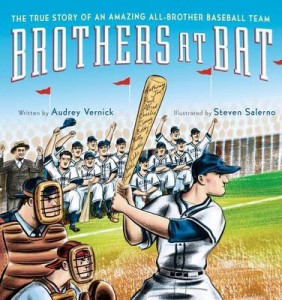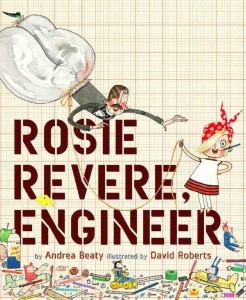Go Out and Play!
 Go Out and Play! Favorite Outdoor Games from KaBOOM! is like a chocolate-covered peanut butter cup: it combines two good things to make something wonderful, and it is something I cannot resist.
Go Out and Play! Favorite Outdoor Games from KaBOOM! is like a chocolate-covered peanut butter cup: it combines two good things to make something wonderful, and it is something I cannot resist.
The peanut-butter-part: Go Out and Play! is a nonfiction book, so sharing it with your students hits that Range of Reading Common Core Standard. Use the the table of contents (nice informational text feature) to help you choose from the dozens of games listed. Use the key at the bottom of each page (another nice informational text feature) to see how many players you’ll need, the recommended age group, how large an area you’ll need, and what, if any, materials you’ll need. Each game has one short page of information explaining how it is played. To build informational reading comprehension, give each student or group of students a page from the book to read. Each group can teach the class how to play that game. (Key Ideas and Details? Check!)
The chocolate part: Go Out and Play! will make your students want to go out and play. So yes it’s an informational book for teaching reading skills, but it’s all about games and playing outside – woohoo! Physical Education teachers will want to keep a copy all to themselves, but get one for your classroom, too, so when your students (or you) need a brain break you can grab this book and play.
When I saw that the author of this book is “KaBOOM!”, I did a little research. “KaBOOM! is a national non-profit dedicated to saving play for America’s children. Our mission is to create great playspaces through the participation and leadership of communities. Ultimately, we envision a place to play within walking distance of every child in America.” Now I like the book even more.
So, choose a game from Go Out and Play! Read how to play the game to or with your students. Then (at the risk of sounding like my mother) go out and play!
For more information about KaBOOM! and its mission to encourage outdoor play, please visit: kaboom.org.
Read MoreBrothers at Bat
Because it is baseball season (go, Tigers!) and because I just found out that I get to go back to New Jersey in September to teach a seminar for preschool and kindergarten teachers, this week I’m featuring a book about baseball written by one of my favorite Jersey girls.
Brothers at Bat: the true story of an amazing all-brother baseball team is written by Audrey Vernick and illustrated by Steven Salerno. In 1938, the twelve Acerra brothers formed their own semi-pro baseball team. With their dad as their coach, the brothers went on to win league championships four times, and earned a place in the Baseball Hall of Fame as the longest-playing all-brother baseball team. Salerno’s art perfectly captures the feel of the 1930s and 1940s. I love the photo at the end of the book showing all the brothers in uniform.
More than just a book about an interesting bit of baseball trivia, the heart of this story is how the brothers were a team for life, both on and off the field. “As the younger brothers grew up,” Vernick writes, “the older ones shared playing time.” When Alfred loses an eye due to a bad bounce of a baseball, his brothers work with him so he can rejoin the team. “He was a pretty good catcher for a guy with one eye,” one brother says. You can discuss with your students all the examples of teamwork in this book to hit the Common Core State Standard of Key Ideas and Details. Talk about teamwork in your classroom. Your students can each make a “baseball” card for themselves, and even team uniforms with white t-shirts and Sharpie markers! Take your students outside for a game of catch with the little bouncy balls from the dollar store. You’ll build hand-eye coordination, cooperation skills, and a sense of teamwork in your classroom. Play ball!
Audrey Vernick has a curriculum guide with lots of discussion questions and ideas on her website: audreyvernick.com. On Steven Salerno’s website you can see some of the illustrations for this book in process: stevensalerno.com.
Read MoreEleanor, Quiet No More
 This morning, I sat basking in the presence of an amazingly talented author. Doreen Rappaport was speaking at our local university, and because my husband, Matt Faulkner, will illustrate her biography of Elizabeth Cady Stanton, Matt and I were able to sit in on her lecture. I’ve been a huge fan of Doreen’s work for years, but hearing her speak made me want to read everything she’s ever written. It reminded me just how powerful it is to hear an author or illustrator in person.
This morning, I sat basking in the presence of an amazingly talented author. Doreen Rappaport was speaking at our local university, and because my husband, Matt Faulkner, will illustrate her biography of Elizabeth Cady Stanton, Matt and I were able to sit in on her lecture. I’ve been a huge fan of Doreen’s work for years, but hearing her speak made me want to read everything she’s ever written. It reminded me just how powerful it is to hear an author or illustrator in person.
Doreen has a series of picture book biographies about famous Americans that perfectly hit that Common Core Standard of Range of Reading for elementary students. I love using her books because her writing style is so engaging that any one of them make for a great Craft & Structure lesson. Take, for example, Eleanor, Quiet No More written by Doreen Rappaport and illustrated by Gary Kelley. Gorgeous, large illustrations accompany the story of Eleanor’s life. Yes, you will find a timeline of her life and key facts to use for writing reports, but more importantly you will get a sense of who this remarkable woman was. Direct quotes are written in huge letters, and discussing why this is can be the beginning of the lesson on author’s craft.
Doreen has video clips of Eleanor Roosevelt and Common Core-aligned study guides with cross-curricular activities on her website, but I think one of the best ways to extend this book is to have your students contact Doreen herself. If you aren’t able to bring her to your school, email her questions, or snail-mail her letters. Allowing your students to personally connect with authors and illustrators will inspire them to appreciate books on an entirely new level. Many authors and illustrators will Skype with students across the country, but check out who lives in your state. Michigan has a list of authors and illustrators available for school visits through the Library of Michigan website. The Society of Children’s Book Writers and Illustrators (SCBWI.org) has a speaker’s list that is searchable by region. All of your students will benefit from hearing an author or an illustrator speak, but for those who dream of making their own books, it may be the spark that lights the next Gary Kelley or Doreen Rappaport.
For more information about the author, please visit doreenrappaport.com.
For more information about the illustrator, please visit garykelleyonline.com.
Read MoreRosie Revere, Engineer
I have the best of reasons for posting late this week: I’ve been on Mackinac Island at the Michigan Reading Association conference, being inspired by dedicated educators and loving the slower pace of an island with no automobiles. Now I’m sitting in a white wicker rocking chair with a cup of coffee and my laptop, dear husband at my side, watching sailboats glide by. The only thing that could make this any better would be a great book, and luckily, I have one.
Rosie Revere, Engineer written by the marvelously talented Andrea Beaty and illustrated by David Roberts is one of the rare rhyming book gems: the story is as solid as the meter and the language isn’t dumbed down in order to make a rhyme. Rosie Revere is the kind of girl most creative people will relate to: joyfully inventive, but so fearful of failure and ridicule that she hides her inventions away. The “gadgets and gizmos” she creates are fantastic, and I love Roberts’ whimsical and yet credible drawings of them. (I myself would love a pair of Rosie’s helium pants.) Rosie’s desire to help her great-great-aunt Rose fulfill her lifelong dream of flying gives Rosie the courage to test one of her inventions.
“The heli-o-cheese-copter sputtered and twitched.
It floated a moment and whirled round and round,
then froze for a heartbeat and crashed to the ground.”
Rosie is devastated by the failure, and by her great-great-aunt’s laughter, until she hears,
“‘Your brilliant first flop was a raging success!
Come on, let’s get busy and on to the next!’“
So not only is the message of this book one that every creative person with perfectionist tendencies needs to hear (I’m keeping it by my bedside table as a reminder) but it has historical notes in it about Amelia Earhart and E. Lillian Todd (the first woman to design airplanes) and Rosie the Riveter and other strong women whose names and deeds should be known. For a social studies lesson, you could easily springboard from this book into studying awesome women inventors. For math-science-art, get graph paper and a bunch of doodads and thing-a-ma-bobs for students to plan, design, build, test, and refine their own inventions. If you ask people to donate old, broken electronic gadgets to your class and bring in small tools, your students can take apart old radios and remote controls to disassemble and use. Build those Phonological Awareness skills by focusing on the rhyme, then discuss the interesting word choices for a Craft & Structure lesson. To keep rocking those Core Standards in Reading, you can easily work in Integrating Knowledge & Ideas by comparing Rosie Revere, Engineer to Iggy Peck, Architect by the same power duo.
So share this book with absolutely everyone you know, and get busy taking creative risks, because
“Life might have its failures, but this was not it.
The only true failure can come if you quit.”
For more information on the author, please visit andreabeaty.com.
For more information on the illustrator, please visit davidrobertsillustration.com.









